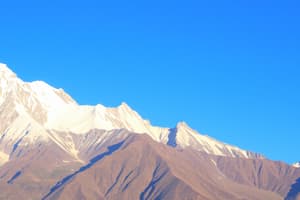Podcast
Questions and Answers
Which of the following is not a wildlife species found in India's arid regions?
Which of the following is not a wildlife species found in India's arid regions?
- Camels
- Wolves
- Elephants (correct)
- Jackals
What is a distinguishing feature of India's western coast?
What is a distinguishing feature of India's western coast?
- Rugged mountains and valleys
- Numerous river deltas
- Islands and archipelagos
- Long sandy beaches and coral reefs (correct)
Which of the following is not one of the island groups mentioned in the text?
Which of the following is not one of the island groups mentioned in the text?
- Lakshadweep
- Lakshwadeep
- Maldives (correct)
- Andaman and Nicobar Islands
What is the primary feature of the Himalayan region described in the text?
What is the primary feature of the Himalayan region described in the text?
What is the primary composition of the Peninsular Plateau region described in the text?
What is the primary composition of the Peninsular Plateau region described in the text?
What is the purpose of the information provided about the contrasting physical features of India?
What is the purpose of the information provided about the contrasting physical features of India?
Which of the following is NOT one of the six major physiographic divisions of India?
Which of the following is NOT one of the six major physiographic divisions of India?
Which mountain range runs along the northern borders of India?
Which mountain range runs along the northern borders of India?
What is the name given to the flat grasslands that extend from the Himalayas north to the Vindhya Range?
What is the name given to the flat grasslands that extend from the Himalayas north to the Vindhya Range?
Which of the following regions covers about one-third of India's landmass in Rajasthan state?
Which of the following regions covers about one-third of India's landmass in Rajasthan state?
Which of the following is NOT a characteristic of the Peninsular Plateau?
Which of the following is NOT a characteristic of the Peninsular Plateau?
Which of the following states is NOT located in the Peninsular Plateau region?
Which of the following states is NOT located in the Peninsular Plateau region?
Flashcards are hidden until you start studying
Study Notes
India, located in South Asia, is characterized by a diverse set of physical features that contribute to its richness and uniqueness. This article provides an overview of the various physical features found within the boundaries of India.
Major Physiographic Divisions
The physical features of India can be broadly categorized into six major divisions:
-
The Himalayan Mountains: Stretching over the northern borders of India, the Himalayas are one of the world's most rugged mountain ranges, running in a west-east direction from the Indus River to the Brahmaputra River. The Himalayas consist of three parallel ranges, with the northernmost range being the Great or Inner Himalayas, containing the highest peaks.
-
The Northern Plains: Also known as the Indo-Gangetic Plains, these flat grasslands extend from the Himalayas north to the Vindhya Range in central India, providing fertile ground for agriculture and hosting many bustling cities, such as New Delhi and Lucknow.
-
The Peninsular Plateau: Composed of igneous and metamorphic rocks with gently rising hills and wide valleys, the Peninsular Plateau is one of the oldest landmasses on Earth. It covers most of southern India and includes regions like Maharashtra, Karnataka, Tamil Nadu, and Andhra Pradesh.
-
The Indian Desert: Also known as the Thar Desert, this region covers about one-third of India's landmass in Rajasthan state. Despite being arid, it is home to various wildlife species, including camels, wolves, jackals, foxes, and the endemic desert monitor.
-
The Coastal Plains: India's coastline stretches over 7,516.6 km (4,671 mi), with the western coast being a major feature of the country. The eastern coast has numerous river deltas and islands, while the west coast is characterized by long sandy beaches and coral reefs.
-
The Islands: India has several island groups, including Lakshadweep off the southwest coast and the Andaman and Nicobar Islands in the Bay of Bengal. These islands are known for their unique ecological systems and diverse flora and fauna.
Contrasting Relief
India's physical features exhibit significant contrasts in relief across different regions. For example:
- The Himalayas have high peaks, deep valleys, and fast-flowing rivers, representing a youthful topography.
- The northern plains are formed of alluvial deposits from the Himalayas and are essential for agriculture.
- The Peninsular Plateau consists of gently rising hills and wide valleys made up of igneous and metamorphic rocks.
Understanding these diverse physical features helps us appreciate the richness and complexity of India's geography and landscape.
Studying That Suits You
Use AI to generate personalized quizzes and flashcards to suit your learning preferences.




